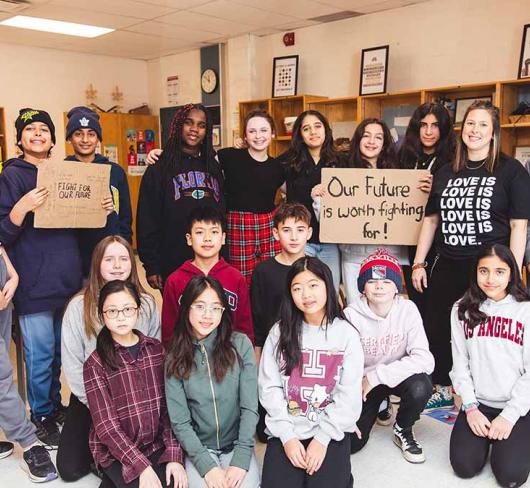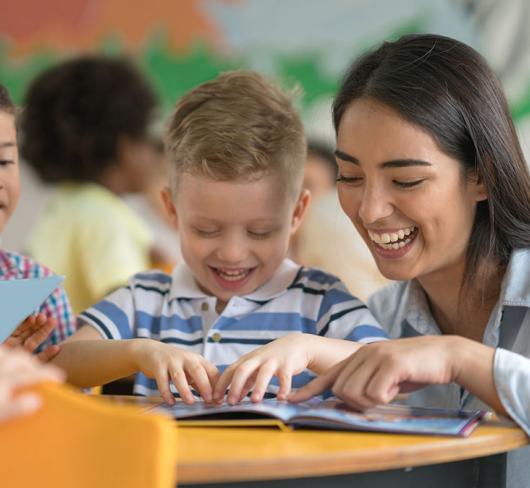
Making My Way in the Makerspace
There is nothing standard about how children learn. Whether sitting or standing, using a pencil or pen, Lego or Keva blocks, every student has their individual preferences, strengths and needs.
In a 2006 TED Talk, which has now amassed more than 75 million views, education expert Ken Robinson contended that “creativity … is as important in education as literacy, and we should treat it with the same status.” As a beginning teacher at the time who had naively believed that students would all sit in neat rows and complete their worksheets or textbook assignments, those words struck me, and my entire approach began to change.
That year was also my first experience with a couple of Grade 4 students who were capable of great things, but weren’t engaged by how they were learning. Neither of those students was able to make it through a day without getting into trouble, and they were beginning to dislike school. I decided to try something different for them and invited them to form a Lego robotics team along with another student.
Lego robotics was not well-advertised in my board at the time, but the design and technology teacher who introduced me to the activity encouraged me to develop a team. Given that this was my first time working with the robots, my focus was more on finding a positive way for that little group of students to engage with school than on having them create award-winning machines. On the day of the robotics tournament, two parents joined us at the event because they were so excited to support their children in this learning opportunity. Despite the fact that the students did not win at any of the individual challenges, they all declared that it had been their best school day ever. Success!
With the elimination of design and technology classes, it is increasingly important to find ways to enable learning and ignite passion in all of my students. I believe that students make up their minds about the subjects they enjoy and will pursue well before they need to choose a secondary school. But I question if students are making informed decisions – if they have had exposure to skills that are used in trades or experiences that might enable their skills to flourish.
Enter the makerspace. A makerspace is a collaborative workspace for making, learning, exploring and sharing tools. When this idea was initially introduced in our board, there were limited workshops offered to teachers on how to use the space. Monthly staff meetings offered a few project ideas that were engaging for the duration of the activity, but did not offer much in the way of immediate takeaway for educators to implement in their classrooms. I loved those activities, and I wanted to help all my students enjoy learning at school as much as I did! I made a conscious effort to begin incorporating hands-on activities into lessons or culminating tasks whenever possible. I built on the concept of the asset model because I wanted to be able to tell the adults at home how well their learners did in school.
When COVID-19 hit, I was relocated to teaching in the makerspace, a room that was set aside for the express purpose of exploring creative endeavors. That setting gave me the best possible opportunity to really put my plans into motion. The room had no bulletin boards for posters, no cupboards to store my teaching materials and no table for guided reading – which was not allowed anyway. I made the most of it. Instead of working among dust-covered boxes filled with mystery contents, I decided to explore. The gift of time that came with the pandemic slowdown was exactly what I needed to reignite my passion for authentic learning and to develop a real approach to differentiated instruction. Yes, paper and pencil activities still occurred in our classroom, but we had Maker Friday every week during which the students and I discovered the contents of the unlabeled boxes. What an experience!
That year, my Grade 4 students and I incorporated plastic Crazy Forts sticks and balls into our geometry lessons to build 3D structures as the skeleton of a fort. We developed working fans, buzzers and lights using conductive Squishy Circuits malleable dough to support our light and sound unit. We played video games using bananas and little cups of water with Makey Makey alligator clips and a circuit board connected to the computer to support our learning of music and coding. We created and held virtual Merge Cube habitats in our hands to learn about using the features of Google slides. We raced cars made with loose parts, Lego and small motors with battery packs while applying our knowledge of gearing up and gearing down from our unit of gears and pulleys. We even used the sewing machine to make animal-shaped pillows to support our habitat presentations. I will not forget how much offering these experiences to students taught me about the undeniable need to meet students where they are.
It is so important that students have the opportunity to try out what they have learned; it is not enough to simply deliver lessons about the theory. Without practice, there may be memorization, but not necessarily real comprehension. In order to determine if instruction has resulted in true understanding of the material, students need to demonstrate their ability.
Differentiation of instruction and professional judgment in the classroom allow educators to be flexible with their approach to engaging students in the learning process and with assessment of learning. There is so much talent that students may not discover and demonstrate if pencil-and-paper tasks are not their strength. The following is a small sampling to illustrate how my makerspace experiences with students allowed them to truly engage with their learning and shine.
Mohamed* was a very shy student who loved talking about his pet birds but struggled to connect with his classmates. The moment he demonstrated a strong skill for building a car out of Lego, the students flocked to him. Mohamed became a group leader. He was revered by his peers for his knowledge of the mechanics involved with putting pieces together with a motor to propel his vehicle forward.
Jules* tried hard to find her place among her peers because she felt that they all had expertise in something. When she showcased her sewing skills with a collection of outfits she made for her dolls to represent the attire worn by an ancient civilization, Jules found her place.
Samantha* loved to dance, but the regular classroom did not allow for her to do the thing she loved the most. At the end of the year, she used her Makey Makey skills to create a dance video game for our arcade game day.
Josie* was a quiet student whose difficulty with spelling did not stand in her way of expertly incorporating an automata into her light-and-shadow box to show movement.
These are but a few examples that demonstrate how important it is that all students have the opportunity to showcase their abilities and understanding and enjoy experiential learning. Proper funding and professional development are essential to the development of this practice. It is more important than ever to help students have varied experiences to prepare them to make informed choices for whatever might lie ahead, and for each student to be able to find success in whatever area of interest they choose to pursue.
Michael Fullan, an expert in educational reform, posits that if we want students to come out of school as adaptive and creative thinkers, we need to provide opportunities to foster those skills all through their schooling experiences. The makerspace is the perfect environment for this to happen. By making mistakes with building or creating, students learn what works and what does not. Making mistakes becomes normalized when every student experiences setbacks and develops the courage to persevere and correct them. Mistakes are what give students pause to rethink an approach and to develop innovation to work towards a new solution. It is precisely when students are encouraged to be creative, without limits, and are provided with logical and tangible steps to guide their idea-development process that they become thoroughly engaged and produce tangible results.
This approach also recognizes that there is nothing standard about creativity. It is as unique as each student who enters my classroom. As Diane Ravitch, a historian of education and the former United States assistant secretary of education noted in a 2015 keynote speech, “Sometimes, the most brilliant and intelligent minds do not shine in standardized tests because they do not have standardized minds.”
As educators, we need to embrace the creativity our students are capable of and create opportunities for them to shine. It is with continued professional development and exposure to a breadth of experiences that teachers can make unique assessment choices to identify and highlight each individual learner’s strengths, which will in turn guide the students toward making informed decisions about their futures.
Students do not all learn in the same way, and therefore should not all be taught and tested in the same way. Our students are remarkable individuals who have tremendous capacity for learning. Educators need to be as brave and creative as their students – to meet them where they are. They are worth it!
Nicole Netherway is a member of the Niagara Teacher Local.

